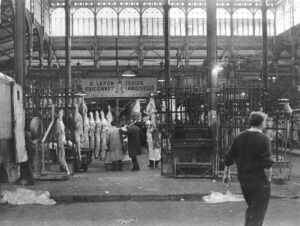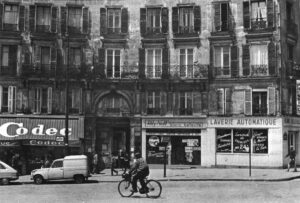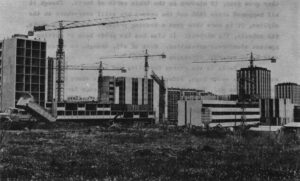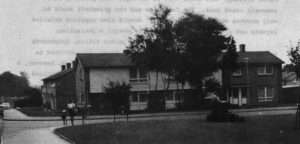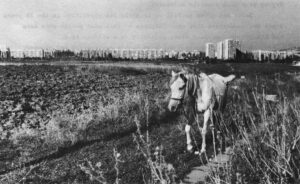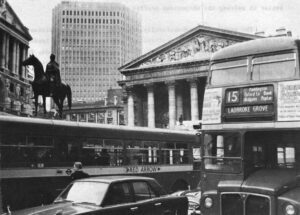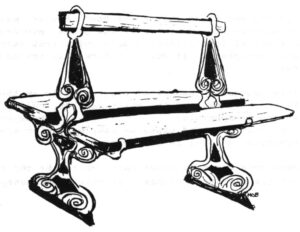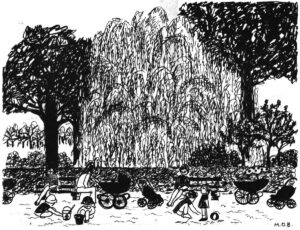LILLE – This is a city that boomed a hundred years ago. They couldn’t build workers’ houses fast enough. Now the coal mines are closing and the factories are antique. The houses built in such a hurry are the same hovels they were, and just as full of people as ever.
Lille-Roubaix-Tourcoing, three cities now a single complex of a million people, built its commerce and its spinning on the steam engine and the coal mines of Pas de Calais, just to the south.
With the steam engine gone, and the coal mines no longer economical, renewal is needed if Lille is to survive. To attract the plastics and electronics industries that are to be Lille’s rebirth requires shiny buildings. So they are being built. There is money to be made, and the industrious Lillois mean to make it.
Renewal of the housing is harder. The setup, peculiar to this region of the north of France, is called a couree. A couree is the backyards of a city block packed tight with hovels. The hovels filled with workers a hundred years ago and have stayed full since.

It is agreed throughout Lille that something must be done. It no longer seems all right, if it ever did, to force people to live without heat or running water in sunless warrens with open sewers.
But houses, even bad old houses, cannot be discarded like worn out machines. These houses are the city. Take them away and Lille is an aging shopping center, Roubaix an aging industrial park. These houses are people’s lives, and people are the city.
It is a question familiar to many American cities. How do you renew a city’s commercial and residential heart? Will the city still be there when you are through?
Lille offers several answers.
JFAN-BERNARD BOQUILLON is the director of the Roubaix-Tourcoing Regional Development Corporation. His answer is to push the courees over with bulldozers.
Boquillon calls himself a technocrat. He has been in Roubaix seven years and is aware he will be elsewhere in his working life. He is in charge of nine urban redevelopment projects.
The biggest is the Anseele renewal area, 400 meters from Roubaix’s central square. He knocked down 1333 buildings, found new housing for 2200 households and 263 businesses. Of the old dwellings 2 per cent were good, 68 per cent were unhealthy, mostly in courees, the rest mediocre.
What is going up (work is nearing completion) is 1000 subsidized “low” rent units, 450 “moderate” rent units, a shopping center, school, old people’s housing unit and parking for 1200 cars.
The city of Roubaix asked Boquillon’s quasi-public company to do the work because it found itself mired in decades of inaction. “It happened all over France,” Boquillon says. “Local government became too used to supervising, and not enough used to developing. Here (gesture includes his room cluttered with plans and designs) we can sign a check in less than a year.”

The quasi-public role is useful, he feels. He has been able to cut across the old divisions between the three cities. It is only within a year that government has created a metropolitan authority to do the same thing. The corporation will go out of business when it is through, in about another five years.
Houses in couree can never be made adequate, in Boquillon’s view – too deteriorated, too mean, too close to the factories they were built to serve. They should be torn down and replaced with better.
Every such project must also include industries and commerce, for they are the city’s tax base. Renewal should aim for the health of the city as a whole. For Roubaix-Tourcoing, Boquillon thinks it is working. “‘I think they are beginning to come up from the bottom,” he says. “I see some signs.”
Boquillon’s approach is like American urban renewal without the bureaucratic stuttering, obvious venality, and public consultation. It is compulsory land assembly and slum clearance, then rebuilding for less shabby use. In seven years Boquillon has torn down 2000 slum dwellings, which is a lot.
He is a man for whom bulldozers arrive on time, and building 10 buildings is only somewhat harder than building one. He has time to talk and few papers to shuffle.
His constituency is the city governments that have hired him. They have the veto power. In fact, however, Boquillon says, it is the architects and financiers who determine which ideas become projects. Local veto is not exercised. The national government’s power of the purse is constantly felt.
People who must be moved are Boquillon’s most intransigent problem, particularly old people. Each family is offered alternative housing. The first place offered is seldom accepted. When couree residents are moved, Boquillon likes to split them up. That way, he feels, old ties are broken and the people brought into the modern world. Left in larger groups, they often try to make a new dwelling into another couree.
After a certain amount of talk and offering of alternatives, a move is forced. “We break a water pipe by accident or something, you know.”
Boquillon is not a man without compassion. He is doing what he believes to be best for all concerned. But he lacks a good alternative to the couree for old people, who find it particularly hard to move away from their lifetime surroundings. he is visibly depressed, his head in his hands, as he describes this insoluble problem.
His hardest problems – the old, the unstable, the least able to cope – Boquillon sends to PACT.
FRANC0IS CHAVANEAU is director of PACT-Roubaix. PACT means Propaganda and Action Contre le Taudis, against slums, and is a national organization.

Chavaneau is interested in renewal of people, however, not cities. He too would push over the courees, but only after he had provided a better home for each couree family and prepared them to live in it.
“We must believe that the situation can be improved,” Chavaneau says. He has spent 19 years in Roubaix, and feels he is only just beginning to see some results. This is not false modesty. The couree remains, and is truly horrid.
Living in the couree means exaggerated infant mortality, tuberculosis, skin disease and mental illness. One in four Roubaix houses, some 9000, are in courees. It means these things for the present North African residents, as it has for a succession of Belgians, Portuguese, Spaniards, and East Europeans.
Couree means no sun in the house because the next house is in the way. It means constant threat of epidemic because of lack of plumbing. It means living on top of each other. A couree puts more people in less space than any alternative housing scheme.
Everybody knows what a slum is, and writing about it is seldom evocative. The actual presence is not so easily dismissed.


“I have brought two dozen ministers from Paris here. They say they didn’t believe such places still exist,” Chavaneau says. “They weep, they say something must be done, and they go back to Paris and they do nothing.”
Chavaneau has become a little hesitant about taking people through the couree, although he says there is no problem of criminality and there certainly is no sense of belligerence. The problem is of pride. “People may think we have come to look at the animals when nothing happens to change the couree. They may be right.”
An article describing Roubaix courees appeared several weeks ago in a national magazine, quoting Chavaneau. The only reaction he has had so far is from the deputy mayor, who said “They exaggerated.” They didn’t.
And so Chavaneau, aware that PACT has made small change, does what he can. They take down one line of courees to give breath to the houses on either side. Paint and install water in another. Convert a disused factory into dwellings. Create halfway houses for families that cannot keep normal housing if they get it.
PA.CT-Roubaix owns some 600 units of housing itself. Eight employees don’t just collect rent, they try to teach people how to live in cities. The Algerians who are the largest group of poor residents of Roubaix, are indeed unfamiliar with the ways of European city life. PACT’s employees are not bourgeois observing the people they try to help, Chavaneau says. They are people from the neighborhood, themselves trained. “Militants,” Chavaneau calls them, people who can understand that words mean different things before and after payday.
PACT tries to respond to every problem brought to it. The gut problem, 9000 houses unfit to live in, is hard to respond to.
Much of the couree is not owned at all, simply abandoned; much is owned by its occupants. That which is rented is owned in small blocks. There is little future in being a slumlord with rents so low. There is also little advantage in maintaining a house.
(Another result peculiar to this pattern of tenancy is that moving a resident out becomes harder as he is unused to paying for his housing at all.)
Attitudes and habits aside, new “low cost” housing simply is too dear for couree residents, though most have full-time employment. The cloth factories, many working three shifts, pay a man about 600 francs a month. The true cost, charges included, of a “low rent” flat approximates 450-500. Rent supplements help, but the low-rent apartment is little solution for the couree dweller. Chavaneau says not a single family moved out in clearing for the Anseele renewal area has moved back into the new housing. He himself lives there.
It is not only money that makes a couree dweller hesitate to leave. He likes it there. Especially for the aged, it provides familiarity, companionship; it is home. Chavaneau, like Boquillon, feels people should be moved out anyway. In the couree they are cut off from the world. If Chavaneau is involved in the move it will be more gentle, more educative. But the idea of a culture of poverty that should be respected and even preserved is quite foreign.
Chavaneau sees the humanity, not the poverty, in the people PACT helps. But poverty is the product of circumstances and ignorance, and is degrading. It is Chavaneau’s calling to remove this degradation.
He has a metaphor, obviously often used:
“If the train thunders through the station, the people cannot get on. If it goes more gently, perhaps they can. It is our job to quiet the train.”

Rousseau and elderly resident discuss repair work.
FRANCOIS ROUSSEAU is director of ARIM-Nord. ARIM (Association de Restauration Immobiliere) is a subordinate branch of PACT, formed to take some national demonstration grant money for rehabilitation of old housing. Rousseau feels his demonstration project, while only two years old, is a success.
The scheme is this. France has fallen disastrously behind in housing. Old houses can be made livable at lower cost than building new. Take an island of old houses, demand that the homeowners fix them up, and show them how to do it.
Rousseau has two such projects, of about 100 houses each, in Lille. One, Ilôt Montagne, is nearing completion.
It is several blocks of small, brick row houses. While they looked kept up, each lacked plumbing, many had other serious drawbacks. Using municipal minimum housing standards, never before applied to old housing, Rousseau went to all the householders and explained:
You must bring this house up to standard. You can do more if you like. If you choose, we will obtain the loan for you, hire the contractor, and follow through. All you need do is say what you want done and sign here.
(The same proposal has proven very effective for American loan sharks and shyster contractors.) The advantages to the householder will be obvious to anyone who has ever called on a contractor for anything. The banks have decided it is good business. Such private banking activity in the home improvement market is unprecedented in France.
The contractor saves administrative time, and can stage work for a full crew through several years. He has offered 30 per cent off his normal price, according to Rousseau.
Administering the demonstration has been very expensive, but on a larger scale should be down to six per cent, Rousseau estimates. He is hoping to expand the project, and has submitted proposals.
The result is very pretty. Nice neat tight houses, freshly painted, with baths and toilets, a few new roofs. A Plexiglas skylight covers what was the open court between house and outhouse. The outhouse is now a proper bathroom, with both toilet and bath.
People seem very pleased to show off their new facilities. Rousseau has obviously kept his fences mended, for he is greeted warmly at every door.
He recognizes that his constant presence in the neighborhood has been a major element in the project’s success, but he feels there are enough people willing and able to be project coordinators. The scale, about 100 houses, and geographical compactness are both crucial.
The approach is not useful where walls are rotten or original design leaves no space for improvement. Costs would be too high. That means it is not a way to fix up real slums.


Two houses in Ilôt Montagne. At top is the horrible example – actually far worse than most. There was a fire, and the house has been bought by ARIM so it won’t pull down the surrounding efforts. The painters were one of two crews that were visible the morning I chanced to be there.
Little attempt has been made to generalize the improvement, to have Ilôt Montagne improve its surroundings as well. When neighbors outside the project area ask help, they are referred elsewhere, Rousseau says.
The project has clearly been designed so success can be measured in numbers of houses made fit. The place for renewal was picked in part because it lacks the problems of an alien subculture found in the couree. It has about it a quality of aid for the deserving poor, which of course is worthwhile. It is preventing the slums of 1980, not curing the slums of 1969.
The Lille rehabilitation is a proud example for the national PACT federation. It was described, complete with color slides of dirty antique toilets, at an international conference in Paris last spring.

PACT sees its role as initiator. It can experiment, find what will work, and keep the grievous lack of housing in France before the public eye. Its central point is that old houses can be repaired cheaply, and cannot be abandoned because France cannot build enough new.
PAUL ROUZÉ, a Lillois and a prosperous engineer-builder, feels it is a matter of honor that his city should thrive.
Rouzé is also president of ARDA-Nord, and Rousseau’s mentor. Because his is an old and prominent family, and because of his business, Rouzé can see anybody, do virtually anything in either the local government or the local agencies of the national government. When Rousseau has a problem, Rouzé can very often solve it. Rouzé ‘s grandfather signed Charles de Gaulle’s birth certificate. Another ancestor built the Prefecture du Nord, which dominates Lille’s monumental central square.
Fostering a slum rehabilitation project is part of what a civilized man should do for his city. It takes a good deal of hard work, which Rouzé provides gladly.
He is very much aware of the region’s need for an industry to replace coal. Facilities must be modernized. There must be increased independence from Paris. He talks about the new university city, to house 80,000, and about the new high speed roads.


He is also aware ARIM’s rehabilitation projects are too limited to be the means of renewing Lille housing. What would it take? “Rentabilite.” Sufficient return on investment. It doesn’t pay, and hasn’t for the last 50 years, to build low rent housing in France.
Lille’s approach to center city renewal is quite unlike an American approach.
In one sense it is more conservative. The dominant force of the national government is not blatant. Everything is done by a subordinate agency of this company with national money, or a quasi-public agency, or a voluntary association with a grant. The need for change is recognized, but always at the same time as the need to preserve what exists. The fabric must not be torn.
The central actors are establishment, moving in their usual quiet way. When something must be done more quickly, a professional is hired to do it. But a Jean-Bernard Boquillon will never take a project and run with it, as might an ambitious mayor



At the same time, Lille can assume that the better-off must be stewards for the less fortunate. The worker would want to become bourgeois, according to this view. In fact it is not even open to question that everyone wants to become bourgeois. There is no question of the propriety of requiring one group of citizens to install toilets, even though half the houses of France lack them. There are no public meetings and surveys asking residents what should be done.
The Lille system does not allow for anyone to come along and say look here, this is horrible, we need action now. This is part of why Lille is so attractive to a visitor – serene, unchanging, ordered. It is also a reason the courees will remain.
But they have been there for a hundred years. Those who don’t like it can continue to go to Paris.
Photos – AB
Received in New York on September 29, 1969.
©1969 Andrew Earl Barnes
Andrew Earl Barnes, Assistant City Editor of The Washington Post, is on leave for a year to study European cities as an Alicia Patterson Fund Fellow.


